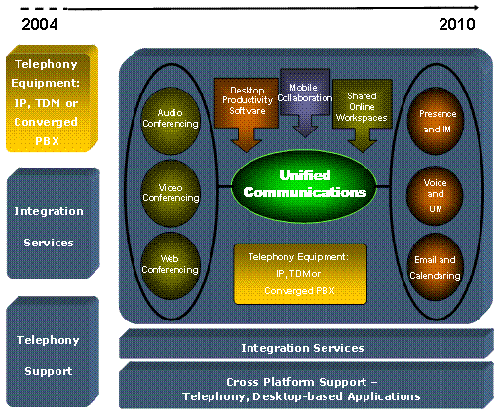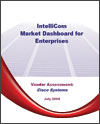October 06, 2006
Telephony Joins the Ranks of a Broader Enterprise Application Portfolio
By TMCnet Special Guest
Krithi Rao, Industry Analyst at Frost & Sullivan
Two events that I attended recently, prompted me to pen down a few thoughts on the state of the telephony market. Event one was VoiceCon Fall 2006, typically a telephony-centric trade show that ironically seemed to center around Microsoft and its announcements this time. However, it goes to show what the future of voice communication and telephony will be like – one more application running on the enterprise network and on desktops.
Event two was Cisco’s Unified Communications Event, where Cisco, popularly hailed as an infrastructure provider, spoke mostly about applications and how really PBXs, routers, switches, phones, gateways are all components used to achieve the end goal of unified communications. Telephony therefore is a component, among other enterprise applications, of unified communications.
Both events delivered strikingly similar messages about the end result of the evolution of the telephony market. However, paths to the end result differ considerably.
IP Telephony Adoption Gives a Boost to Non-PBX Markets
Markets
The recent VoiceCon show held in San Francisco confirmed the industry’s continued migration to VoIP with most telephony vendors displaying the most recent version of their IP-based solutions and messaging vendors displaying their migration-friendly hybrid solutions that can run on TDM
with most telephony vendors displaying the most recent version of their IP-based solutions and messaging vendors displaying their migration-friendly hybrid solutions that can run on TDM and IP. However, what struck me was that the continued penetration of IP telephony in the enterprise seems to be the source of growth not only for the telephony market but a few other markets as well.
and IP. However, what struck me was that the continued penetration of IP telephony in the enterprise seems to be the source of growth not only for the telephony market but a few other markets as well.
Opportunity for New Applications
The message is getting pretty clear that a significant amount of the IP migration is happening not just because of toll savings but because of the applications that can be deployed on the IP telephony infrastructure. Accordingly, there was a plethora of communication applications being displayed or introduced that leverage the IP PBX.
migration is happening not just because of toll savings but because of the applications that can be deployed on the IP telephony infrastructure. Accordingly, there was a plethora of communication applications being displayed or introduced that leverage the IP PBX.
These applications ranged from user-centric productivity applications to network-centric monitoring/assessment applications, all the way up to mobility solutions. Many of these application vendors have embraced the SIP standard. Some others have further partnered with individual telephony vendors to work with the PBX vendors’ specific version of the SIP standard. As we know, although SIP is bringing telephony solutions into the standards-based world, PBX vendors are still including proprietary hooks to create “stickiness” to their solution.
standard. Some others have further partnered with individual telephony vendors to work with the PBX vendors’ specific version of the SIP standard. As we know, although SIP is bringing telephony solutions into the standards-based world, PBX vendors are still including proprietary hooks to create “stickiness” to their solution.
On the productivity applications front, companies such as Litescape were displaying how they were using IP to reach into the enterprise infrastructure and leverage CRM information and biometrics to bring additional capabilities to the IP phone on the user’s desk top. One of the most widely quoted customer cases is Mitsukoshi, one of Japan's upscale department stores, offering "intelligent fitting rooms". LiteScape's RFID and XML-based applications allow busy shoppers to have merchandise delivered directly to the fitting room without needing to exit the room, walk out into the store, and search the shelves.
Mobility solutions were also in the spotlight. Some companies such as Ascendent Systems (News - Alert) were publicizing how their Ascendent Voice Mobility Suite delivered the identity (internal extension, caller ID, etc.) and functionality of the corporate phone system (PBX) to any remote device – a capability made easier due to IP infrastructure.
Finally, I could see some traction on the network monitoring and assessment front. Companies such as SyncVoice, which provides network management and monitoring solutions, are betting their cards on the fact that IP PBX solutions and hybrid environments with IP and TDM will need constant infrastructure monitoring.
Boost to the Infrastructure Market
IP migration is giving a boost to the underlying infrastructure market as well. So far, little has been said about gateways in the enterprise telephony market. However, with a significant portion of the market still having legacy TDM infrastructure, enterprises will be requiring gateways to communicate with deployed IP telephony infrastructure, with ITSPs and between IP networks. Accordingly, companies that provide media gateways for the enterprise such as Citel, Quintum and Cantata expect to use the industry’s gradual migration to IP as a source of growing revenue.
Telephony Equipment Service is no longer the Stepchild
Due to the complexity that accompanies IP telephony deployments, services now play an important part of the telephony deal. Previously overshadowed by vendors, channel partners such as resellers, VARs, service providers and system integrators are now the deal-breakers in the IP telephony deal and heroes of the VoiceCon show.
What’s remarkable is the interest of diverse parties in offering services due to the potential revenue that is to be made in this market. Avaya (News - Alert) with its announcement of hosted IP solutions, NEC with its launch of a managed service solution, IBM (News - Alert) with its launch of “Converged Communications Services”, and Verizon with yet another announcement of a managed services telephony solution (this one with Alcatel (News - Alert)) marks the beginning of the battle of equipment vendors and service providers for the same telephony service market.
Further, as alluded to in a recent Frost & Sullivan industry outlook briefing, unified communications is going to further change the face of the telephony service industry. The following figure shows the pivotal role services is expected to play with the advent of unified communications.

Unified Communications – Hype or Hope?
As seen at VoiceCon as well as at other industry events or forums, lately, vendors from all walks of the enterprise communications market seem to have one major objective on their minds – unifying infrastructure and providing users a unified interface to multiple communication and productivity applications. Vendors are aggressively pushing consolidated voice, instant messaging, videoconferencing and e-mail, which can accelerate business communications and enhance productivity.
At the VoiceCon show, a lot of emphasis was placed on the conference within the conference dedicated to Unified Communications. Not surprising, considering most market participants expect VoiceCon to be called “UnifiedCon” in the future. Telephony vendors proceeded to display their own presence servers (the heart of the unified communications solution), side-by-side with Microsoft’s Live Communication Server (soon to be called Office Communications Server).
However, the infancy of this concept is seen in the fact that in the forum that was meant to bring to light how different companies were using unified communications in their business, most of the participants ended up speaking of silo-ed applications to a certain extent – conferencing, messaging and IM. Although one of the organizations had deployed a presence server, that’s exactly what they were currently using it for – checking presence of colleagues.
All Roads Lead to Unified Communications – Prepare!
Frost & Sullivan believes that, depending on which vendor delivers it, true unified communications (UC) will encompass a variety of different applications – from virtually every piece of collaboration software (IM, audio conferencing, Web conferencing and video conferencing), to voice, e-mail, and in many instances data portals and group collaboration. A true end-to-end solution will have seamless integration among the various components, will use knowledge and expertise about the company’s business process, and will use knowledge of that industry vertical’s functions to provide targeted applications and a unified user interface that will improve user productivity.
The end result has been determined - PBXs, routers, switches, phones, gateways will all be components used to achieve the end goal of unified communications. What’s to be noted is that several different markets will have to prepare for this fast approaching paradigm shift. This is largely because unified communications does not just impact the telephony solution, but other parts of the enterprise infrastructure as well. For example, UC will affect the underlying data network architecture and infrastructure providers will have to optimize their offerings for existing converged enterprise applications and prepare for new multi-modal type applications.
Application vendors such as those providing collaboration software (IM, audio conferencing, Web conferencing and video conferencing), voicemail, e-mail, data portals and group collaboration have to prepare for the inevitable integration into a unified communication solution.
Unified communications is also expected to be the link between the enterprise and the contact center solutions. Companies are expecting to use presence and unified communications to provide cross-communication capabilities to their employees. For example, a call center agent having a complicated question will be able to detect and hunt down a knowledge worker in the enterprise and use his/her knowledge to provide immediate answers to the customer on the phone.
Thus contact center solution vendors and customers alike have to prepare for the integration of the previously silo-ed groups. Migration to IP in the enterprise posed the challenge of making the TDM infrastructure and the new IP infrastructure inter-work. However, with the slow rate of adoption of IP in the call center, the integration challenge is extending beyond the enterprise to include integration with contact center legacy infrastructure.
The Unified Communications Battle
UC is opening up the enterprise communication market out to vendors such as IBM, Microsoft and Oracle that are increasingly posing a competitive threat to the telephony vendors such as Cisco, Avaya, Siemens and Nortel. Coming in from different directions including telephony, router/switch, collaboration and databases, these vendors all have the resources and motivation to participate in this market due to the impending convergence of their solutions.
However, the most talked about battle today is the one among Cisco, Nortel and Microsoft that are leading vendors in the three major markets of telephony, data infrastructure and applications, and are engaged in complex relationships of co-opetition.
Cisco and Microsoft were able to cooperate effectively as long as the targeted domain was clear: Cisco focused on infrastructure, Microsoft on the applications. But IP is changing the paradigm such that networking isn't just about routers and switches but also about applications and solutions. Thus Cisco is being made to re-visit its so far uncomplicated relationship with Microsoft.
Another important reason for the “re-visit” is the partnership announced by Microsoft with Nortel in July 2006. Microsoft and Nortel made the announcement that they have embarked on a broad, four-year alliance to develop and market unified communications products and services. While this is being seen as a significant development for the fast evolving unified communications market, questions are being raised on Microsoft’s involvement with other PBX vendors and Nortel’s continuation as a separate entity in the market.
The top vendor in question in regards to Microsoft’s other PBX vendor partnerships is Cisco. Having been mostly in the application space, Microsoft had been lacking in resources and expertise in communications. Nortel may just complete Microsoft’s portfolio and let it cross domains and, therefore, may take precedence over Microsoft’s relationships with other vendors.
Cisco, on the other hand, has felt the need to send the message to the market that its relationship with Microsoft is not competition but “co-opetition”. Cisco is sending out the message that, in effect, it will do what’s best for the end customer. However, to do that, Cisco will have to change its closed solution approach to where it will have to make its collaboration environment more accessible to third-party developers. Cisco expects to do just that by opening out its application layer with its Service Oriented Network Architecture (SONA).
And then there was more: Oracle's Collaboration Suite already provides IM, e-mail, videoconferencing, voice, calendaring and scheduling based on Oracle's relational database. As of September 2006, Oracle has completed work on Virtual PBX, one of the core communications applications of the company's Service Delivery Platform (Oracle SDP). Tailored for any size business, Virtual PBX is a business phone system that provides voicemail, fax-mail and queues and attendant tools to handle incoming calls without major changes to existing network architecture. Although more of a hosted offering, it just signals the entrance of new competition in the space due to “all roads leading to unified communications.”
Thus, in summary, the enterprise communications market is now in what’s considered a state of flux. Companies are continuing to flesh out their portfolios. However, we expect vendors to continue to partner with and develop synergies with those who once were or eventually will become their competitors.
Overall, we believe that unified communications, telephony equipment service capabilities and convergence with contact center solutions will represent the major trends that determine the winners and losers in the enterprise communications marketplace.
Krithi Rao is an industry analyst for Frost & Sullivan’s Enterprise Communications (News - Alert) division. For more information about this article, or other Frost & Sullivan analysis, please contact Mireya Castillla.














